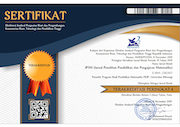Analisis faktor kesulitan terhadap kesalahan penyelesaian soal persamaan linier berdasarkan klasifikasi Taksonomi Bloom (Studi kasus terhadap mahasiswa Teknik Informatika 2015/2016)
Abstract
Mathematics is usually regarded as the hardest lesson by children and adults. It is seen students do not seem interested in mathematics, so students often make mistakes when they do exercises because they feel difficulty in doing it. The factors causing learning difficulties consist of two kinds, internal factors and external factors of students. Mistakes made by students need to be further analysed so that we get a picture of the weaknesses of students. The purpose of this study is knowing each type of error percentage of students in working on the material linear equation based on Bloom’s taxonomy and determine the level of difficulty of the error factors influence students. This research is a descriptive research with quantitative and qualitative approaches. This study was conducted in Technic Faculty, Muhammadiyah University of Ponorogo with research subjects class 2A. Data collection techniques in this study were done by using a test, interview techniques, and questionnaires technical. As for the analysis of the data referring to the model of Miles and Huberman which includes data reduction, a data display, drawing a conclusion. Testing the validity of the research result data was conducted by the credibility test, transferability test, dependability test, and confirmability test. Based on the results of data analysis can be concluded percentages of each type of error in the students working on the linear equation based bloom taxonomy is as follows: 1)The percentage of this type of error (PP-C1) is 10.71%. 2) The percentage of this type of error (PP-C2) is 17.86%. 3) The percentage of this type of error (PP-C3) amounted to 39.29%. 4) The percentage of this type of error (PP-C5) of 21.43%. 5) The percentage of this type of error (PP-C4) amounted to 28.57%. The level of difficulty factor effects in working problems of student’s mistake are for an internal factor which includes “very strong influence†classification is an indicator of intelligence and factor which include “strong influence†classification is an indicator of attitudes, interest, and motivation. As for external factor which includes “strong influence†is an indicator of teaching method.
Full Text:
view PDFReferences
Anderson, Lorin W dan David R. Krathwohl. 2010. Pembelajaran, Pengajaran, dan Asesmen. Yogyakarta: Pustaka Belajar.
Hidayati, Fajar. 2010. Kajian Kesulitan Belajar Siswa Kelas VII SMP Negeri 16 Yogyakarta Dalam Mempelajari Aljabar. Universitas Negeri Yogyakarta
Kumalasari, Ellisia. 2009. Analisis Tingkat Kognitif Pertanyaan pada Buku Teks Matematika Kelas VII Pokok Bahasan Bilangan Bulat Berdasarkan Taksonomi Bloom. Universitas Jember.
Muijs, Daniel dan David Reynolds. 2008. Effective Teaching Teori dan Aplikasi.Yogyakarta: Pustaka Belajar.
Syah, Muhibin. 2013. Psikologi Pendidikan Dengan Pendekatan Baru. Bandung: PT REMAJA ROSDAYA
Ulifa, Siti Nur. 2014. Hasil Analisis Kesalahan Siswa Dalam Menyelesaikan Soal Matematika Pada Materi Relasi. Jurnal Pendidikan Matematika STKIP PGRI Sidoarjo. Vol. 2, No. 1, hal. 124. ISSN: 2337-8166. Diunduh pada tanggal 11 Januari 2015.
DOI: https://doi.org/10.37058/jp3m.v2i2.163
Refbacks
- There are currently no refbacks.
©2017 JP3M (Jurnal Penelitian Pendidikan dan Pengajaran Matematika)
Program Studi Pendidikan Matematika
Fakultas Keguruan dan Ilmu PendidikanÂ
Universitas Siliwangi
Jl. Siliwangi No. 24 Kota Tasikmalaya - 46115
email: jp3m@unsil.ac.id
e-ISSN: 2581-2807 ; p-ISSN: 2460-8599

This work is licensed under a Creative Commons Attribution-NonCommercial-ShareAlike 4.0 International License.
StatCounter:
Detail


